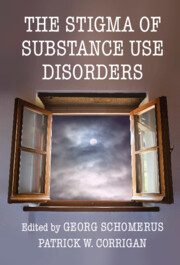Book contents
- The Stigma of Substance Use Disorders
- The Stigma of Substance Use Disorders
- Copyright page
- Contents
- Figures
- Tables
- Contributors
- Chapter 1 Understanding the Stigma of Substance Use Disorders
- Chapter 2 My Experience with the Stigma of Substance Use
- Chapter 3 Substance Use Stigma and Policy
- Chapter 4 Experiences of Stigma and Criminal In/Justice among People Who Use Substances
- Chapter 5 Substance Use Disorders, Stigma, and Ethics
- Chapter 6 Intersectional Stigma in Substance Use Disorders
- Chapter 7 International Perspectives on Stigma toward People with Substance Use Disorders
- Chapter 8 Using Community-Based Participatory Research to Address the Stigma of Substance Use Disorder
- Chapter 9 Three Competing Agendas of Addressing Stigma of Substance Use Disorder
- Chapter 10 The Benefits of Disclosure
- Chapter 11 The Role of Peers in SUD Stigma Change
- Chapter 12 The Role of Media Reporting for Substance Use Stigma
- Chapter 13 Reducing Substance Use Stigma in Health Care
- Chapter 14 Final Considerations and Future Directions for Erasing the Stigma of Substance Use Disorders
- Index
- References
Chapter 9 - Three Competing Agendas of Addressing Stigma of Substance Use Disorder
Published online by Cambridge University Press: 23 June 2022
- The Stigma of Substance Use Disorders
- The Stigma of Substance Use Disorders
- Copyright page
- Contents
- Figures
- Tables
- Contributors
- Chapter 1 Understanding the Stigma of Substance Use Disorders
- Chapter 2 My Experience with the Stigma of Substance Use
- Chapter 3 Substance Use Stigma and Policy
- Chapter 4 Experiences of Stigma and Criminal In/Justice among People Who Use Substances
- Chapter 5 Substance Use Disorders, Stigma, and Ethics
- Chapter 6 Intersectional Stigma in Substance Use Disorders
- Chapter 7 International Perspectives on Stigma toward People with Substance Use Disorders
- Chapter 8 Using Community-Based Participatory Research to Address the Stigma of Substance Use Disorder
- Chapter 9 Three Competing Agendas of Addressing Stigma of Substance Use Disorder
- Chapter 10 The Benefits of Disclosure
- Chapter 11 The Role of Peers in SUD Stigma Change
- Chapter 12 The Role of Media Reporting for Substance Use Stigma
- Chapter 13 Reducing Substance Use Stigma in Health Care
- Chapter 14 Final Considerations and Future Directions for Erasing the Stigma of Substance Use Disorders
- Index
- References
Summary
Efforts to reduce stigma of substance use disorder can be described by three sometimes-competing agendas: (1) the services agenda, which aims to reduce public stigma that often serves as a barrier to treatment-seeking; (2) the rights agenda, which aims to replace stigma with rightful opportunity and full social inclusion; and (3) the self-worth agenda, which centers empowerment and self-determination over shame. Sometimes efforts to further one of these agendas can unintentionally undercut the efforts of another. However, efforts that elevate the lived experience voice may be critical in reducing stigma without undermining the various agendas. As researchers, advocates, and people with lived experience work to understand and reduce the stigma of substance use disorder, each must be intentional with their efforts to ensure that their pursuit in the name of one agenda does not impede the progress of the others.
- Type
- Chapter
- Information
- The Stigma of Substance Use Disorders , pp. 163 - 179Publisher: Cambridge University PressPrint publication year: 2022

